Indian fisheries are one of the most important food production sectors. It not only provides nutritional security but also contributes to agricultural export. It provides livelihood to almost 15 million people in the country. Due to the increase in the consumption of fish products the country has shown continuous and sustained increment in fish production. This sector contributes to 1.1% of the GDP and 5.15% of the agriculture GDP. Today ornamental fish culture and high-value Biofloc farming are gaining importance along with the food fish culture.
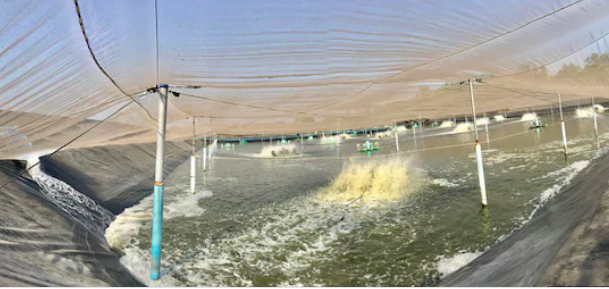
What is Biofloc Fish Farming?
Biofloc technology is a technique of improving the quality of water by balancing carbon and nitrogen in the system. The technology works on the flocculation principle. Biofloc was introduced as a technique to promote intensive fish production in a limited area. The main purpose of Biofloc is to recycle nutrients by converting unused feed and waste organic matter into food using probiotics and carbon sources. It was developed as a substitute to open pond fish farming and to prevent the introduction of diseases into the water.
It is an initiative that is not only cost-effective but also sustainable and environmentally friendly. In India, the population is increasing every day and the demand for aquaculture is also increasing with it. India contributes to over 6% of global fish production. But the expansion of aquaculture is circumscribed mainly because of the two reasons, first, as it put pressure on the environment by discharging waste materials into the water bodies, and second, because of the dependence on fish oil and fish food.
Biofloc technology works as a solution to these issues as it is a profitable method of intensive fish farming because it controls the water quality and produces proteinaceous feet in situ. Biofloc act is a wastewater treatment method and provides aquatic animals with nutrition.
The acceptance of Biofloc technology in outdoor and indoor systems has been well documented and indoor culture tests have shown significant differences in terms of production and productivity. The microbial structure in triggering the immunity of animals remains unclear and the massive role of Biofloc technology can be well adopted in India to raise the standards of fish and shrimp farming activities in India. This new technology will help boost fish production in the country and encourage local people to participate in farming activities in the country.
Need for Biofloc technology:
The fishery is one of the biggest food sources in the world. The fishery is done by raising and harvesting fish for food consumption. It is one of the biggest sources of employment. As the demand for seafood consumption is increasing, the demand for aquatic products used for the industrial sector for conversion into fish meal and fish oil products is also increasing. Therefore we can say that the consumption of fish is increasing with the increase in population.
But the growing demand for fish can not be fulfilled by using the traditional methods of fish farming. With the changing times fishing industry has adopted a more innovative and efficient method of raising and harvesting fish to sustain the requirement. India is a developing country and there are a lot of poor farmers who earn their livelihood through fish farming. But, traditional farming becomes expensive for them, and because of government limitations, it becomes hard for them.
The traditional system uses little or no fishmeal and farmers supply nutrient-rich material to the water to enhance the growth of algae and other organic matter on which the fish feed. This inspired researchers to develop Biofloc technology where nitrogen is waste generated by the cultivation of organisms and is converted into bacterial biomass. Biofloc comes here as a cheap and affordable technology. It converts the toxic materials into useful products and acts as a retention belt for nutrients in the pond and reduces maintenance costs.
Biofloc technology reduces water pollution and the risk of introduction and spread of pathogens. Biofloc technology reduces the utilization of protein-rich feed and the cost of standard feed and increases productivity. This technology works best with species that can derive the nutritional advantage from the direct consumption of frock and who can tolerate high solids concentration in water and are generally tolerant of poor water quality. Biofloc technology keeps the water quality high and results in a great production of fish.
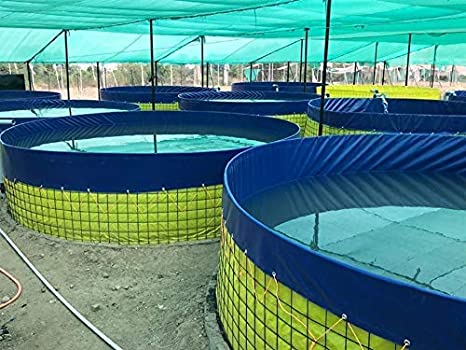
Steps of Biofloc Fish Farming:
Step 1: Setting up the pond/ tank:
The first and foremost thing which is to be done is to find a perfect place for the tank or the pond in which the cultivation would take place. This could be a bit tricky if you aren’t mindful of the subtle factors responsible for the growth like the position of the sunlight, temperature of the place, ventilation of the place, etc. But for the most part, it comes in with the experience and the mastery of the craft as and when time surpasses.
All the above-mentioned things have an effect either negligibly but truly, but here comes the takeaway: If you’re planning for a pond then make sure that it should be lined with some protective layer such that there’s no influence of soil on the water content. This is because of the fact that the major contaminants come from the bed of the pond, as the soil is rich in heavy metals like Arsenic, Methyl Mercury, Selenium, and cadmium, and sometimes soil also contains remnants of fertilizers.
The best possible solution for this would be that you should go with a tank rather than a pond. And if a pond is the only option you’re left with, then line it up with concrete.
Step 2: Aeration:
So, if you’re done with the above procedures properly, we shall move onto the next and extremely important step i.e. installation of aerators. Aerators are the components of the system which are responsible for maintaining the entropy of the suspended particles of algae, bacteria, protozoa, etc. which are the food for the fish and it also maintains the optimal oxygen distribution throughout the tank/ pond in order to prevent the formation of anaerobic zones which promotes the formation of methane and ammonia.
This can odorize the mixture resulting in the degradation of the quality of the harvest. Plus placing the aerators in an orderly fashion aids in a laminar and quiet flow which can save you energy and hence money as it directly affects the quality of produce.
Step 3: Selection of species and other related stuff:
Alright, so are you done with the above step. If yes is your answer then we shall proceed further to the next and another major step that is the ‘selection of species’. Though it has been seen that almost every other species of fish can be cultivated using Biofloc, thanks to the improved culture water quality, but there are a few species like those of catfish and Barbs which it has been found out that these face difficulties in thriving in the culture water due to the high solid suspended particle content which make the water too murky for the to effectively grow. So, what’s the solution then? It’s fairly simple!
We’d like to have a species that is the most biologically efficient species for that particular culture, water, and conditions. Now, how do we do that? The answer is the Internet! There are data based on all the above parameters, readily available on the internet and it would barely take a few clicks to find your perfect match. So now that you’ve selected the best possible species for your farm, it’s our duty to be a bit conscious about what our guests would have in their meals, but in a very scientific manner.
Step 4: Optimization of Carbon and Nitrogen:
Not getting into the scientific depth, let us just skim through the optimization part. There is a minuscule problem of ammonia peaks into the system if something goes wrong like for e.g. one of the aerators has ceased to work. In these kinds of scenarios due to the sheer nitrogen content, the formation of ammonia can take place and if that remains the case for a long time it could turn into a nightmare for your flocs and fishes. The carbon in these carbohydrates lets the heterotrophic bacteria multiply and synthesize ammonia, thus maintaining water quality.
So again, optimization of carbon is also a significant thing to deal with. Let’s see what experts have to say for the same. “We advise that you select only carbon sources and feed mixtures with a carbon-to-nitrogen (C/N) ratio above 10 as this favors the growth of these heterotrophic bacteria. Since most fish and shrimp feeds have a C/N ratio of 9:1 or 10:1, additional inputs are needed to raise this ratio to between 12:1 and 15:1.
Any material that contains simple sugars and breaks down quickly can be used, such as molasses, cassava, hay, sugarcane, or starch. Another solution is to reduce the protein content of the used feeds.” To prevent ammonia peaks at later stages of the production process, this step should be repeated, especially when using high stocking densities in combination with large amounts of artificial feeds. Controlling this is one of the hardest steps for successfully implementing Biofloc principles.
Step 5: Biofloc growth:
Now that the genius inside of you has managed to crack down the above steps, let’s delve into the realm of Biofloc growth. So, until now we’ve set up all things in possibly the best way. Now the time has arrived to start with our cultivation. We’ll be planting the seeds for different algae, bacteria, protozoa into the culture water with a few probiotics to amp up the process, and within a matter of weeks the number of flocs would reach from almost negligible to four to five flocs per milliliter.
You’d be thinking that “what’s the big deal here, this is quite gettable”, right? You’re absolutely right until you’ll find out the progress of the next couple of weeks or so. This is the power of exponents. Within a matter of days, the floc number would wreak havoc and grow blazingly fast as if a nuclear fission reaction would’ve instigated. And guess what, you’re now at about 10 billion bacteria per cubic centimeter of the culture water.
Isn’t that amazing? Surveillance of the growth of these flocs can be done by using a cone-shaped beaker or a flask for that matter, to collect several water samples at a depth of 15cm to 25cm, preferably in the late morning. The solid particles should be left to settle for 20 minutes. They will stick to the sides of the cone-shaped beaker, making it easy to count them.
Step 6: Monitoring, Harvest, and Clean-up:
Water samples must be regularly taken to monitor the pond water and determine the activity of the two Biofloc types plus their respective densities. With the stock growing and feeding volumes increasing, a tipping point will be reached wherein the water will remain brown. Once the Biofloc system has turned brown, aeration must be significantly increased to sustain a high respiration rate. Good maintenance and monitoring of the aerators themselves, plus the power system that provides the energy to run the system.
Regular monitoring of water quality parameters, especially dissolved oxygen and ammonia levels, will give an idea if the system is working well, or if the aeration needs to be increased further. Regular monitoring of the performance of the farm stock, calculating and recording growth rate, overall appearance, FCR, and stock survival is required. You should thus notice a big jump when comparing current farm records with the previous, traditional non-Biofloc farm operations.
After following the steps a farmer can notice the change in the cost and profitability. Proper cleaning and preparation of the pond setup for the raceway is important after harvest time. After some time heavy metal can build up in the culture water which can make the stock answer table for consumption. Thus, cleaning up well before starting your next profitable batch is necessary.
Growth performance in Biofloc system:
The performance of aquatic animals in a Biofloc system is analyzed by the following parameters, such as the growth of fishes based on length and weight at intervals of every 15 days. You can analyze by weighing 10 fish from each treatment that replicates randomly. Fishes have to starve overnight before checking their weight.
Fish length is measured using a measuring scale and the wait is measured using an electronic weight balance. The growth performance is analyzed by using different formulas with the help of parameters like specific growth rate- SGR, percentage of weight gained-PWG, feed conversion ratio-FCR, protein efficiency ratio-PER, biomass, and survival rate.
The formulas are SGR(%) = LOG e final weight of the fish – Log e initial weight of the fish/ number of days x 100. PWG(%) = Final weight of the fish- initial weight/ initial weight x 100. FCR = Feed dry weight (given)/ Bodyweight gain of the fish (wet weight of the fish) PER = Body weight gain of the fish (wet weight)/ crude protein feed. Survival rate(%) = Total number of Harvested Animals from the fish culture/ Total number of stocked Animal x 100.
Advantages of Biofloc technology:
• Reliable and profitable method of farming.
• Minimise water exchange and water usage in the aquaculture system.
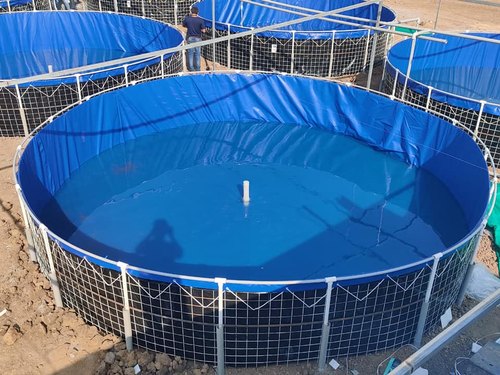
• Produce low-cost Bioflocs, rich in protein.
• Provide more economical alternatives and additionally a potential gain on feed expenses making it less expensive.
• Biofloc systems maintain water quality by reducing water pollution and reduce the introduction and spread of pathogens.
• Limited or zero water exchange.
• Biofloc systems use cheaper food fish and trash fish feed formulation.
• Biofloc system is an eco-friendly culture system that reduces the environmental impact on aquatic culture.
• Improves land and water efficiency.
• Biofloc system resulted in higher productivity as it enhances the growth performance, feed conversion, and survival rate in the fish culture system
. • Reduce pressure on the fisheries.
• Biofloc system reduces the cost of protein-rich feed and it turns the cost of standard feed which makes up to 60% of the total production cost.
Disadvantages of Biofloc fish technology:
• Reduce response time due to water respiration rates are elevated.
• Seasonal and inconsistent performance for sunlight exposed systems.
• Alkalinity supplement required.
• Increase the energy requirement for mixing and aeration.
• Start-up period required.
• Increased pollution potential from nitrate accumulation.
• Increased instability of nitrification.
Conclusion:
Biofloc can be considered as a budget-friendly innovative technology where the toxic material is converted into the proteinaceous feed. Biofloc technology application does offer good benefits in improving aquaculture production that could contribute to the achievement of sustainable development goals.
Although Biofloc technology is still in its infant stage it may be developed and performed in integration with other food production, and does promote productive integrated systems, aiming at producing more food and feed from the same area of land with fewer inputs. This technology could result in higher productivity with less impact on the environment. Biofloc technology is a green approach in aquaculture known in a different name such as zero exchange autotrophic, single-cell protein production system, etc.
Now Biofloc has been focused internally as a very useful alternative protein for fish meal mainly produced in the form of microbial meal. Biofloc technology is at the forefront of fish production many people who have invested in this method have earned heavily from it as it has improved production and profit. It has also reduced the time it takes to raise fish, which means that fish can be raised multiple times within a given time.
Thus, the Biofloc technique is beneficial in rearing and raising fish. Social media snippet: Are you facing challenges in keeping your fish healthy? Are your fishes getting rejected every time you get them to the fish oil factory? You’re at the right place! Biofloc is the new way to go. A simple, cheap yet effective technique for getting rid of all the above problems in a healthy and natural way. Short Article: Indian fisheries are one of the most important food production sectors. It provides livelihood to almost 15 million people in the country and contributes to 1.1 % of the GDP and 5.15 % of the agriculture GDP.
The traditional method cannot meet the demand of rising fish consumption, it is not only expensive but also harmful to the environment. Biofloc technology is a technique of improving the quality of water by balancing carbon and nitrogen in the system.
The main purpose of Biofloc is to recycle nutrients by converting the used feed and waste organic matter into food. It was developed as a substitute to open pond fish farming, to prevent the introduction of diseases into the water, and to enhance environmental control over fish production in areas where water is scarce and land is expensive. The key to the system is waste treatment.
Applying the Biofloc technology, farmers can raise fish in artificial tanks with high densities in an area of between 150 to 200 square meters connected with piped water supply. The system can be used to produce freshwater fish species such as tilapia, pangasius, common carp, and others. It has also reduced the time it takes to raise fish, which means that fish can be raised multiple times within a given time. Thus, the Biofloc technique is cheaper and beneficial in rearing and raising fish.

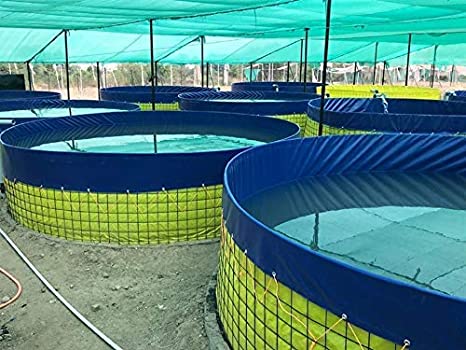
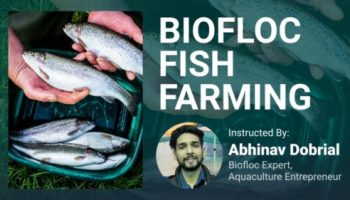

2 Responses
We want to have a fish tank into which regularly bore water will be pumped.We want to draw water from this tank to use for agriculture purpose.We will maitain water level.Will this work. If we have a poultry farm on top of this tank will it help .The droping of poultry may be feed for fish.Will it work?
This is the right blog for anybody who wishes to understand this
topic. You know a whole lot its almost tough to argue with you (not that I actually would want to…HaHa).
You certainly put a brand new spin on a topic that’s been discussed for a long time.
Wonderful stuff, just excellent!
My homepage kkm